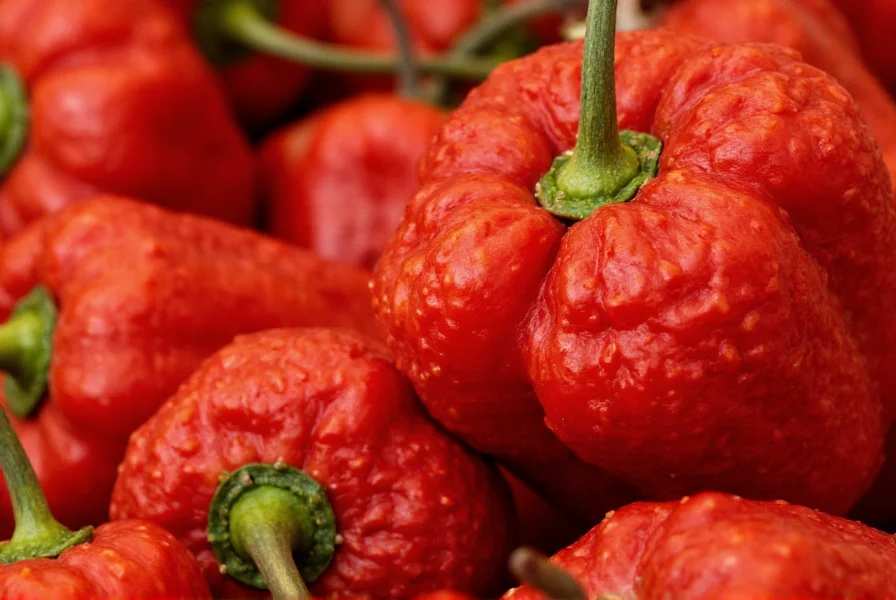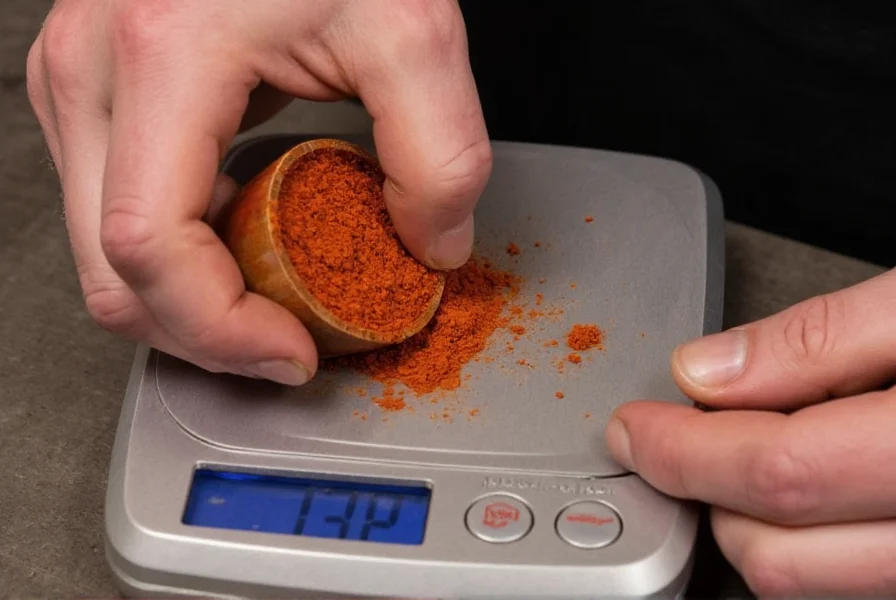Understanding pepper heat requires knowledge of the Scoville scale, the standard measurement for chili pepper pungency. Developed by pharmacist Wilbur Scoville in 1912, this scale measures the concentration of capsaicinoids—the compounds responsible for a pepper's heat. While many peppers claim extreme heat, only those rigorously tested through high-performance liquid chromatography (HPLC) provide scientifically valid measurements that replace the original subjective human tasting method.
The Science Behind Extreme Pepper Heat
Pepper heat originates from capsaicin and related compounds concentrated primarily in the placenta (the white ribs inside the pepper). When consumed, these compounds bind to TRPV1 receptors in the mouth and throat, triggering a burning sensation. The Carolina Reaper's extreme heat comes from its genetic lineage, combining the Naga Morich from Bangladesh and the Red Habanero from the Caribbean.
| Pepper Variety | Average SHU | Peak SHU | Guinness Record Status |
|---|---|---|---|
| Carolina Reaper | 1,641,183 | 2,200,000+ | Official Record Holder (2013-2023) |
| Pepper X | 2,693,000 | 3,180,000 | Unofficial Claim (2023) |
| Dragon's Breath | 2,480,000 | 2,480,000 | Not Certified |
| Trinidad Moruga Scorpion | 1,200,000 | 2,000,000 | Former Record Holder |
| Naga Viper | 1,382,118 | 1,382,118 | Former Record Holder |
Understanding Pepper Heat Measurement
The transition from the original Scoville Organoleptic Test to High Performance Liquid Chromatography (HPLC) has revolutionized pepper heat measurement. While the Scoville method relied on human testers diluting pepper extract until heat became undetectable, HPLC provides precise chemical analysis of capsaicinoid concentration. This scientific approach eliminates subjectivity and provides consistent, comparable measurements across different laboratories.
It's important to note that pepper heat varies significantly based on growing conditions, soil composition, climate, and even the specific plant. A Carolina Reaper grown in optimal conditions might register 50% higher on the Scoville scale than one grown in less ideal circumstances. This natural variation explains why official records specify average heat levels rather than single extreme measurements.

Safety Considerations for Handling Extreme Peppers
Working with the world's hottest peppers requires serious precautions. Capsaicin is oil-based and not water-soluble, meaning water won't alleviate the burn once exposure occurs. Professional growers and handlers use the following safety protocols:
- Wear nitrile gloves (latex provides insufficient protection)
- Use safety goggles to prevent accidental eye exposure
- Work in well-ventilated areas to avoid inhaling capsaicin particles
- Have milk or yogurt nearby (casein helps break down capsaicin)
- Avoid touching face or other body parts during handling
Medical professionals warn that consuming extremely hot peppers can cause severe reactions including temporary loss of consciousness, esophageal damage, and in rare cases, more serious complications. The body's response to extreme capsaicin exposure triggers an inflammatory reaction that can mimic heart attack symptoms, leading to unnecessary emergency room visits.
Practical Uses for the World's Hottest Peppers
Despite their extreme heat, peppers like the Carolina Reaper have legitimate culinary and medicinal applications. In small, carefully measured quantities, they're used in:
- Specialty hot sauces where a few drops provide significant heat
- Pharmaceutical research for pain management compounds
- Natural pest deterrents in organic farming
- Topical pain relief creams (capsaicin is FDA-approved for this purpose)
- Culinary experiences where heat is part of the novelty
Chefs who work with these peppers emphasize precision—using scales that measure to 0.01 grams—and often recommend starting with dried pepper powder rather than fresh peppers for better control. The key to using these peppers successfully is understanding that less is more; a tiny amount can transform an entire dish.

Debunking Common Misconceptions About Extreme Peppers
Several myths persist about the world's hottest peppers that deserve clarification:
- Myth: The hottest peppers are dangerous to consume
Fact: While extremely uncomfortable, consuming even the hottest peppers in moderation doesn't cause permanent damage for healthy individuals - Myth: All record-claiming peppers are officially certified
Fact: Many "hottest pepper" claims lack proper laboratory verification through standardized testing protocols - Myth: Heat is the only important characteristic
Fact: Flavor profile matters too—Carolina Reaper offers fruity, sweet notes beneath the heat that many hot pepper enthusiasts appreciate - Myth: The hotter the better for all applications
Fact: Different culinary and medicinal applications require specific heat levels—extreme heat isn't always desirable
The Future of Superhot Peppers
Pepper breeding continues to push heat boundaries, with researchers exploring genetic modifications and selective breeding techniques. However, practical limitations exist—peppers beyond a certain heat threshold become increasingly difficult to handle and have limited culinary applications. The current focus in pepper research has shifted toward developing peppers with specific flavor profiles at various heat levels rather than simply pursuing maximum heat.
As analytical methods improve and our understanding of capsaicinoid genetics advances, we may see more precise breeding of peppers with targeted heat levels and flavor characteristics. This scientific approach could lead to specialty peppers designed for specific culinary applications rather than novelty heat records.
Frequently Asked Questions
What is the hottest pepper in the world as of 2023?
The Carolina Reaper maintains the official Guinness World Record as the hottest pepper, with an average Scoville rating of 1,641,183 SHU. While Pepper X claims higher measurements (approximately 2.7 million SHU), it hasn't received official Guinness certification as of 2023.
How hot is the Carolina Reaper compared to a jalapeño?
A typical jalapeño measures between 2,500-8,000 Scoville Heat Units, while the Carolina Reaper averages over 1.6 million SHU. This means the Carolina Reaper is approximately 200-650 times hotter than a jalapeño, depending on the specific peppers being compared.
What happens if you eat a Carolina Reaper?
Eating a Carolina Reaper typically causes intense burning in the mouth and throat, followed by sweating, flushing, and potentially temporary loss of breath control. Some people experience "ghost pepper headaches" or nausea. While extremely uncomfortable, these effects are temporary and not dangerous for healthy individuals. Medical professionals recommend consuming dairy products like milk or yogurt to alleviate the burn, as capsaicin is fat-soluble.
How do you safely handle the world's hottest peppers?
Always wear nitrile gloves (not latex) and safety goggles when handling superhot peppers. Work in a well-ventilated area, avoid touching your face, and have dairy products nearby. Never use bare hands, and be careful when cutting peppers as capsaicin can become airborne. After handling, wash all surfaces with soapy water and dispose of gloves properly—don't touch doorknobs or other surfaces with contaminated gloves.
Can eating the hottest peppers cause permanent damage?
For healthy individuals, consuming even the hottest peppers in reasonable quantities doesn't cause permanent damage. The body's reaction—intense burning, sweating, and flushing—is temporary. However, people with gastrointestinal conditions like ulcers, IBS, or GERD should avoid extreme peppers as they can exacerbate symptoms. In extremely rare cases, excessive consumption has led to temporary complications like thunderclap headaches, but no verified cases of permanent damage exist from normal consumption.











 浙公网安备
33010002000092号
浙公网安备
33010002000092号 浙B2-20120091-4
浙B2-20120091-4